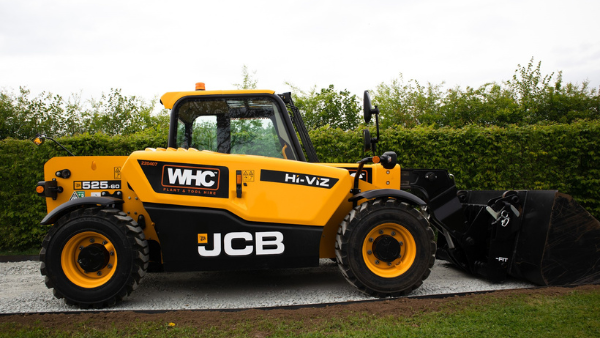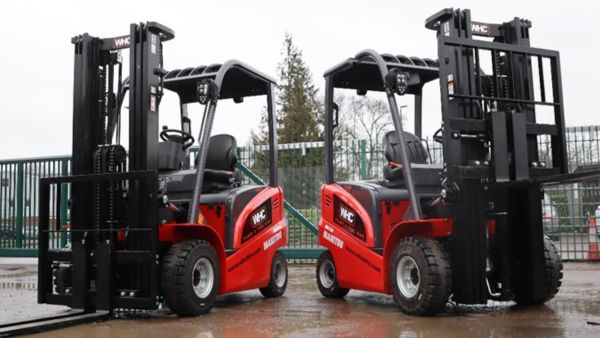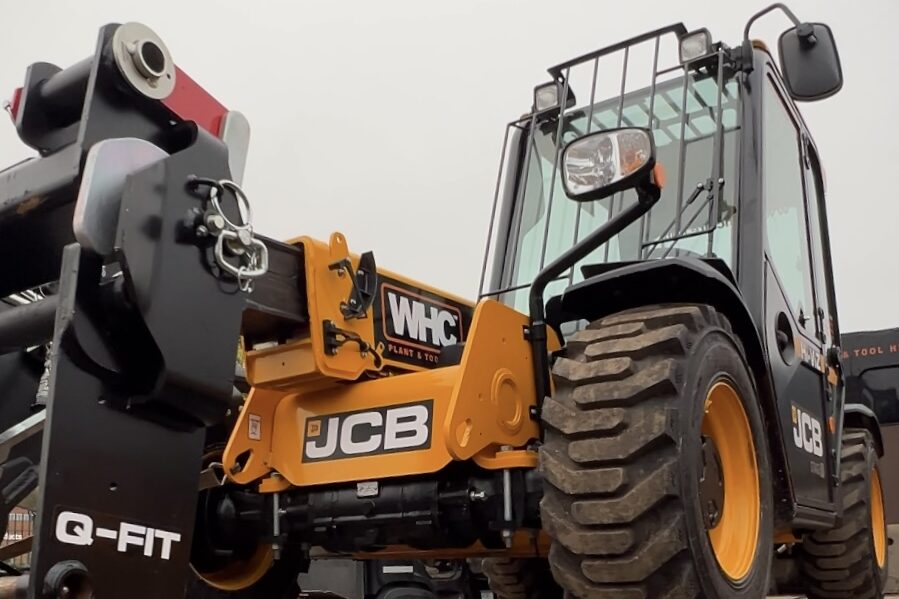Telehandler vs Forklift: Which Is Right for Your Construction Site?
Choosing the right lifting equipment for your construction site can make or break your deadline. For many site managers, moving heavy materials, unloading deliveries, and navigating pallets around a busy site raises important questions about efficiency and safety.
Two of the most common choices for these types of tasks are telehandlers and forklifts. But which one fits your application best?
In this WHC Hire article, we’ll cut through the jargon and clearly explain the key differences between telehandlers and forklifts—exploring their strengths, limitations, and when each is the smarter choice for your construction project.
What’s the Difference Between a Telehandler and a Forklift?
At first glance, both telehandlers and forklifts could be mistaken for one another. However, this couldn’t be further from the truth. While both machines lift, move, and place loads, their design, functionality, and capabilities are quite different.
What Is a Telehandler?

Telehandlers, also known as telescopic handlers, are highly versatile pieces of lifting equipment. They feature a long, extendable boom that can reach both upward and outward, allowing operators to place loads at significant heights or distances.
Their combination of power, reach, and all-terrain tyres make telehandlers ideal for uneven ground and outdoor worksites. Many models can also be fitted with a variety of attachments—such as buckets, winches, or lifting jibs—making them a flexible choice for many construction applications.
Key Advantages
- Extended Reach: Unlike forklifts, telehandlers can lift materials to much greater heights and distances, often up to 14 metres or more.
- Versatility: With various attachments like buckets, forks, and winches, telehandlers can adapt to multiple tasks.
- Terrain Capability: Telehandlers are built for rough and uneven terrain, making them suitable for outdoor environments.
What Is a Forklift?

Forklifts, by contrast, are primarily designed for lifting and moving palletised loads across flat, stable surfaces. Their compact and agile design allows for easy manoeuvring in warehouses, storage yards, and loading bays, where space is limited.
While forklifts excel at moving materials efficiently and safely at ground level, they’re not suited to rough terrain or extended reach tasks. Their strength lies in precision handling and stability in confined, indoor environments.
Key Advantages
- Manoeuvrability: Forklifts excel in tight spaces, making them ideal for indoor use.
- Ease of Operation: They are simple to drive and handle, even in busy environments.
- Efficiency: Perfect for quick loading and unloading tasks in warehouses or on docks.
When considering telehandlers vs forklifts, it’s important to evaluate the specific needs of your project. Below is a comparison chart of these two lifting machines.
| Feature | Telehandler | Forklift |
| Reach | Extends up and forward with a telescopic boom. | Lifts loads directly up and down, with a much shorter reach. |
| Terrian | Designed for uneven, rough outdoor construction sites. | Best suited for indoor surfaces which are smooth and flat, such as warehouses. |
| Versatility | Highly versatile. Able to handle a wide range of attachments such as buckets, working platforms, sweepers, and more. | Less versatile. Primarily used for lifting and moving pallets. Some fork attachments are available, but very limited. |
| Manoeuvrability | Less manoeuvrable, however offers 3 different drive modes to maximise manoeuvrability in tight applications. | Highly manoeuvrable and compact. Perfect for indoor work where space is limited. |
| Power | Diesel-powered, some electric or hybrid models available | Electric, diesel-powered, LPG, hybrid. |
| Best For | Lifting materials to high or difficult-to-reach spots, placing loads over obstacles, and working on a complex outdoor job site. | Loading and unloading lorries in a loading bay, working on flat, hard surfaces, and moving materials in tight, indoor environments. |
When to Use a Forklift on a Construction Site

Forklifts are ideal for construction sites with smooth, level ground where materials only need to travel short distances. Their compact design makes it easy to navigate materials around sites with limited space, making them perfect for jobs with restricted access.
These lifting machines are particularly useful for indoor tasks, such as warehouse environments, or on well-paved construction sites. Unlike telehandlers, forklifts are less suited to rough terrain or slopes. That said, some equipment suppliers can provide rough terrain forklifts, which offer improved stability and vertical lifting capabilities on more challenging surfaces.
When a Telehandler Is the Better Choice

For most UK construction sites with outdoor, uneven surfaces or multiple levels, a telehandler is often the more favourable choice. Unlike forklifts, telehandlers can navigate rough terrain while transporting and lifting materials to heights that would otherwise require specialised equipment.
Telehandlers also support a wide range of attachments, making them far more versatile than forklifts. This versatility allows site managers to maximise the machine’s usage without the need to continually hire or purchase additional equipment.
Another key advantage is that many telehandlers can be hired ready to operate on public roads—a significant benefit for new-build construction sites that require flexible and mobile lifting solutions.
Are Telehandlers Better Than Forklifts?
Whether a telehandler or forklift is better depends entirely on your site requirements.
If most of your work takes place indoors on level surfaces, where noise, emissions, and manoeuvrability are key considerations, a forklift is an efficient and cost-effective solution.
However, on construction sites where operators need to navigate uneven terrain while transporting and lifting materials to elevated work areas, telehandlers are usually the smarter choice. With their superior reach, adaptability, and versatility, telehandlers provide significant value for large-scale and complex projects.
On major construction sites, telehandlers are often among the first pieces of plant equipment to arrive and one of the last to leave. Hiring can also be highly beneficial, helping to reduce the upfront cost of ownership while ensuring your project has the equipment it needs.
Is a Telehandler Classed as a Forklift?
While telehandlers and forklifts share some similarities, they are not classed as the same type of machine.
A telehandler is technically considered a type of crane, equipped with an extendable boom that affects the machine’s centre of gravity depending on the load, reach, and angle. Forklifts do not have these features, so they are classified differently.
Operators of telehandlers also need to understand load charts and stability factors, which go beyond the skills required to operate a standard forklift. It is important for site managers to know that holding a forklift licence does not automatically qualify someone to operate a telehandler safely.
Can You Hire a Telehandler Without a Licence?
Yes! Anyone can hire a telehandler without holding a licence. However, to operate the machinery safely on a UK construction site, the operator must demonstrate competency. Most reputable construction companies employ operators who hold CPCS or NPORS certification for telehandlers.
For more guidance on safety, compliance, and best practices when using a telehandler on your site, check out this article: The Ultimate Telehandler Hire Guide for Business.
Choosing the Right Equipment Partner
When deadlines are tight, it’s essential to partner with a reliable telehandler hire supplier that can deliver the right equipment on time.
WHC Hire Services offers:
A Modern Fleet
Our state-of-the-art, low-hours fleet from world-leading manufacturers ensures scalability, fast delivery, and minimal downtime on your projects.
Expert Support
We help match your specifications to the right machine, while providing mobile support throughout your hire to keep your operations running smoothly.
Flexible Hire Rates
Whether you need a telehandler for a single day or up to 12 months, WHC’s flexible long-term hire rates help you manage costs while keeping your project on schedule.
Fast Delivery
With a large fleet and high availability, WHC can deliver telehandlers to your site at short notice.
Supporting Business With Telehandler Hire
If you are preparing for a major build or want to make the most of your telehandler hire investment, careful planning can make all the difference.
Explore our in-depth resource: The Ultimate Telehandler Hire Guide for Business. This guide covers everything UK businesses need to know before, during, and after your telehandler hire, including:
- Choosing the correct machine size and attachments for your project.
- Comparing hire vs buy economics to save costs and reduce maintenance responsibilities.
- Ensuring safety and compliance, including operator competence, load charts, and UK road-law requirements.
- Avoiding common mistakes, such as last-minute bookings, selecting the wrong machine, or overlooking site-specific conditions.
Quick Telehandler vs Forklift FAQs
1. What machine lifts higher?
Telehandlers generally offer superior lift reach, often exceeding 17 m, depending on the model and attachments. Forklifts typically reach heights of around 6 m.
2. Can I use a telehandler or forklift on the road?
Yes. Both telehandlers and forklifts can be used on public roads if they meet the necessary road-legal requirements, are taxed and insured, and the operator holds a valid UK driving licence.
3. Is it cheaper to hire a telehandler or a forklift?
Costs depend on the machine’s specifications and the duration of hire. While there may be some variation, there is usually no significant difference between the two. It’s always best to request a quotation from a reputable hire provider like WHC Hire Services.
Conclusion

When it comes to choosing between telehandlers and forklifts, the right equipment selection depends on your site’s environment and lifting requirements. Forklifts excel at indoor work on flat, stable ground, while telehandlers deliver unmatched versatility across a wide range of applications.
Looking for reputable telehandler hire in Gloucestershire, Worcestershire, or Oxfordshire? Award-winning supplier WHC Hire Services provides the expertise, equipment, and support that reputable construction companies rely on.
Explore our telehandler hire options or contact your local depot today for a fast, personalised quotation.

